Poker Ranges: Poker Range Charts to Play Winning Poker
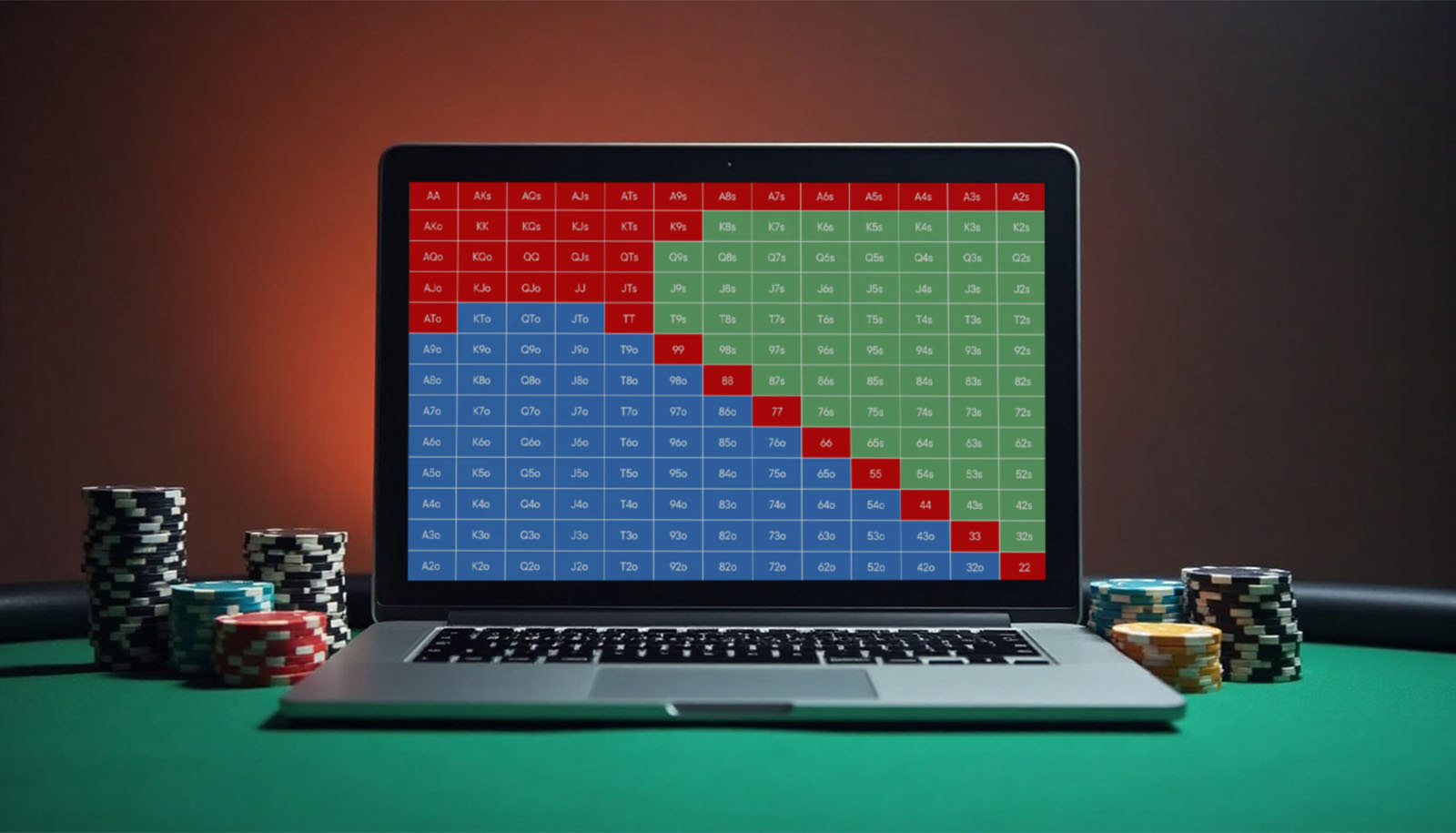

- Fact Checked by: PokerListings
- Last updated on: May 19, 2025 · 25 minutes to read
Table of Contents
Improving at poker requires considering a multitude of intricate aspects, and Poker Ranges are no exception. Understanding and skillfully analysing Poker Ranges is often what separates a beginner from a more seasoned player. This ability plays a critical role in making informed decisions and gaining a competitive edge at the table. But how can one analyze Poker Ranges effectively and use this knowledge to improve their chances of winning? This text will provide answers to these important questions.
Understanding of Poker Ranges
Understanding Poker Ranges is crucial for poker players looking to improve their game, especially in high-pressure scenarios like short-stacked play. Imagine being down to just a few chips, forced to decide whether to shove or fold with a marginal hand. Poker range charts provide a clear solution by describing the optimal hands to play common preflop situations when the pot remains unopened. By mastering these ranges, pofessional poker players can ensure their decisions are not easily exploited, giving them a strategic edge. Learning poker ranges is an important step in improving your preflop strategy and confidence at the poker table.
What Are Poker Ranges
Poker ranges are a way to describe a group of potential hands a player might hold in a given situation. Instead of attempting to pinpoint specific hole cards, which is nearly impossible, players estimate the range of many hands an opponent could have. For instance, a very tight player reraising preflop may indicate a range consisting only of premium hands like aces or kings. Conversely, a player frequently in action might have a much wider range, including almost any two cards. Understanding and evaluating these ranges is essential for helping players make more informed decisions at the table.
Four Types of Poker Ranges
Range in poker vary depending on the situation and the hand in play. With certain hands, players may opt to preflop raise, while with others, it’s more strategic to wait for the first open cards. Understanding these ranges can significantly impact decision-making, as they help define the actions a player should take in various scenarios. Below are four key types of poker ranges that every player should familiarize themselves with to improve their game.
Open Raising Ranges
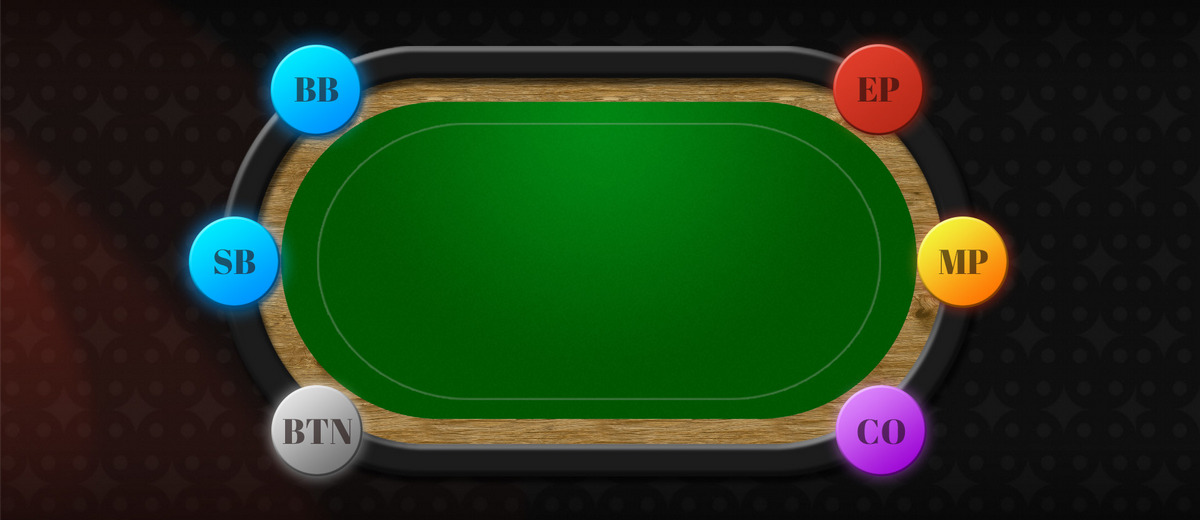
Open raising ranges refer to the hands a player chooses to raise with when first to act in a round, typically from various table positions. These ranges are influenced by the player’s position and the strength of their hand. For example:
- Early Position (EP): Players should open raise with strong hands, approximately 16.1% of possible hands, including all pocket pairs from 22 upwards, suited high cards like AQs+, and suited connectors like KQs.
- Middle Position (MP): The range expands to about 20.3%, adding hands like AJo and additional suited connectors.
- Cut-off (CO): Players can open with around 27.3% of hands, incorporating weaker suited connectors and broadway hands.
- Button (BU): This is the most advantageous position at the poker table, allowing for an open raising range of approximately 42.8%, including a wider array of suited connectors and weaker broadway hands.
- Small Blind (SB): Similar to the Button, with an open raising range of about 44.8%, but adjustments may be necessary based on the tendencies of the players in the Big Blind.
Calling Ranges
Calling ranges are the hands a player chooses to call a raise with, rather than folding or re-raising. These ranges depend on factors such as the player’s position, the raiser’s position, and the specific dynamics at the table. For instance:
- Against an Early Position Raise: Players might call with pocket pairs from 22 to JJ, suited connectors like 65s+, and suited broadway hands.
- Against a Middle Position Raise: The calling range can include similar hands, with slight adjustments based on the raiser’s tendencies and table dynamics.
- On the Button (BU): Players have the advantage of position and might call with a broader range, including suited aces and additional suited connectors.
3-Bet / 4-Bet / 5-Bet Ranges
These ranges pertain to re-raising strategies after an initial raise:
- 3-Bet Range: Typically includes premium hands such as AA, KK, QQ, JJ, and AK. Against opponents with a wide opening range, players might also include hands like AQs and TT.
- 4-Bet Range: Often consists of the strongest hands like AA and KK. However, against aggressive 3-bettors, players might incorporate bluffs with hands like A5s to balance their range.
- 5-Bet Range: Generally reserved for the absolute strongest hands, primarily AA and KK, especially in deep-stacked situations.
Postflop Ranges
Postflop ranges involve decisions on whether to continue in a hand after the community cards are revealed. Factors influencing these ranges include:
- Board Texture: Players should continue with hands that connect well with the board, such as top pair, flush draws, or straight draws.
- Position: Based on your position, players gain more flexibility to continue with a wider range of hands.
- Opponent Tendencies: Against aggressive opponents, players might tighten their postflop range, whereas against passive opponents, they might continue with a broader range.
Understanding of poker postflop ranges is crucial for maximizing profitability and is a topic explored in various poker strategy resources.
Poker Range Formats
Effective poker strategy hinges on the ability to quickly and accurately visualize hand ranges during live play. This skill allows players to make informed decisions by calculating potential hands of their opponents might hold. To facilitate this analysis, four primary formats are employed to represent poker ranges, each offering unique insights into hand selection and strategic planning.
The Poker Hand Matrix
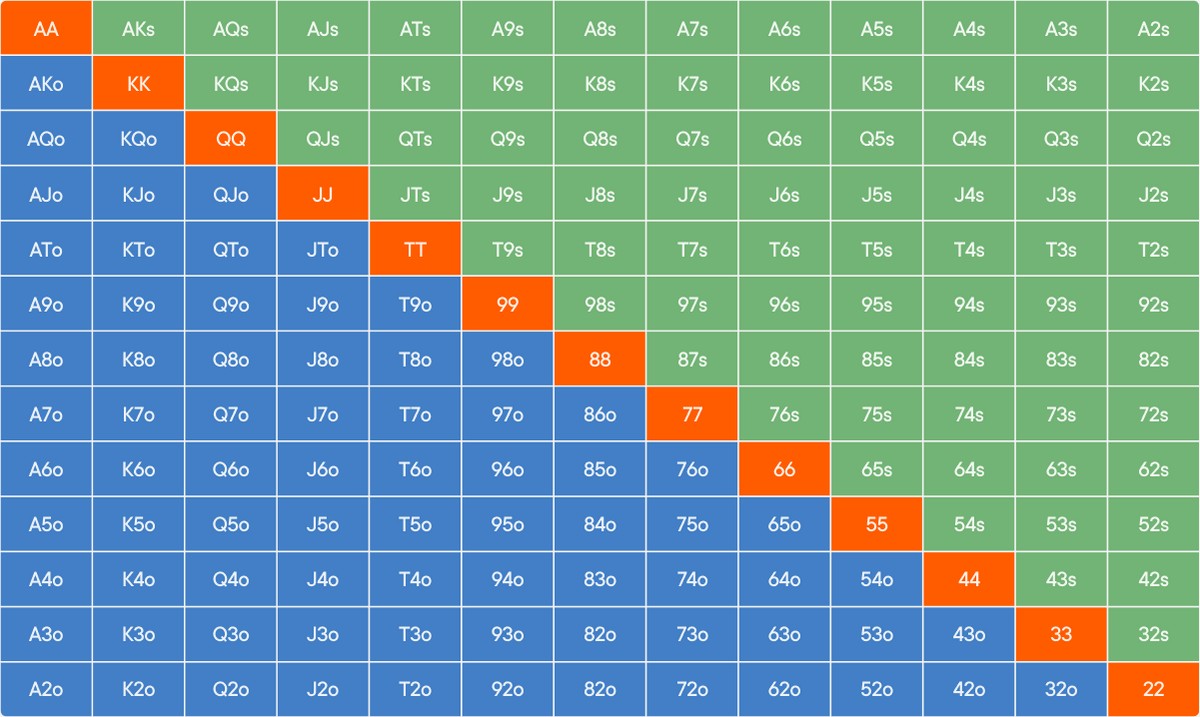
The Poker Hand Matrix is a 13×13 grid that systematically displays all 169 possible starting hands in Texas Hold’em. Pocket pairs are positioned diagonally from the top-left to the bottom-right, while suited and offsuit combinations occupy the upper and lower triangles, respectively. This visual tool allows players to quickly assess and select specific hands, aiding in the construction and analysis of hand ranges. By highlighting particular cells within the matrix, players can effectively communicate and strategize about potential holdings.
Percentage Form (%-Form)
Percentage Form represents the proportion of all possible starting hands that comprise a given range. With suits factored in, the 169 potential starting hands expand into 1,326 unique hand combinations. To calculate the percentage form of a specific hand, the number of its possible combinations is divided by 1,326. For instance, pocket Aces have six possible combinations, meaning their percentage form is approximately 0.45% (6/1,326). This method is particularly useful when correlating observed playing frequencies with specific hand selections. If an opponent raises 15% of the time preflop, this format allows players to construct a range that aligns with that frequency, improving their ability to anticipate likely hands.
Range Combos
Range Combos focus on the exact number of possible combinations for each hand within a range. Understanding that there are six combinations of each pocket pair, four suited, and twelve offsuit combinations for non-paired hands enables precise calculation of an opponent’s potential holdings. For instance, recognizing that there are 16 total combinations of Ace-King (four suited and twelve offsuit) allows players to assess the likelihood of an opponent holding this hand. This detailed analysis is crucial for making informed decisions based on the frequency of specific hands within a range.
Range Strand
The Range Strand utilizes textual notation to concisely represent hand ranges. Common shorthand includes symbols like “+” to denote all hands of a certain category and higher. For example, “22+” signifies all pocket pairs from twos upward, while “AQ+” encompasses Ace-Queen and stronger hands. This format is especially beneficial in written communications and forums, allowing for clear and efficient sharing of range information without visual aids.
How to Calculate Poker Ranges
Understanding and calculating poker ranges is fundamental for players aiming to enhance their strategic decision-making. By integrating tools like Heads-Up Displays (HUDs) and engaging in combinatorial calculations, players can refine their ability to read opponents and adjust their strategies accordingly. Several key factors influence the determination of ranges, each contributing to a comprehensive analysis of the game.
Using HUD and Poker Tools
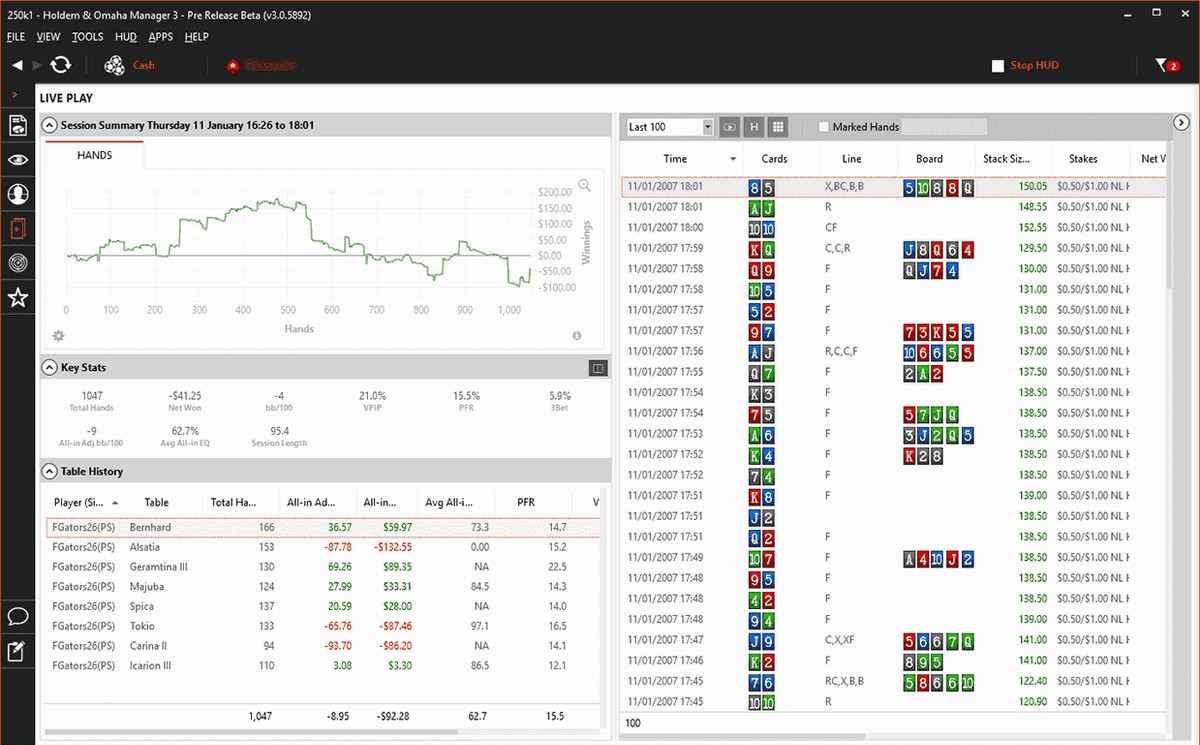
HUDs and various poker software tools have become indispensable for modern players seeking to analyze and calculate poker ranges effectively. HUDs provide real-time statistics on opponents’ behaviors, such as their VPIP (Voluntarily Put Money in Pot) and PFR (Pre-Flop Raise) percentages. By interpreting this data, players can deduce the likely range of hands an opponent plays from different positions. For instance, a player with a high PFR from an early position may have a tighter, stronger range. Additionally, tools like equity calculators allow players to input specific ranges and community cards to determine the equity of their hand against an opponent’s range. This quantitative approach aids in making informed decisions about whether to call, raise, or fold in various scenarios.
Combinatorial Calculations
Combinatorial analysis involves assessing the number of possible hand combinations an opponent might have, providing a more precise understanding of their range. In Texas Hold’em, there are 1,326 possible starting hand combinations, including 169 unique hand types when suits are not considered. By analyzing factors such as the player’s position, betting patterns, and the community cards, one can narrow down the plausible hands an opponent holds. For example, if the board shows three hearts and an opponent raises significantly, combinatorial calculations can help estimate the likelihood that they have a flush, based on the number of heart combinations available. This method enhances decision-making by providing a structured way to evaluate the strength of an opponent’s potential hands.
Key Factors Affecting Ranges
Several critical factors influence the determination and calculation of online poker ranges:
- Position: A player’s position at the table significantly affects their range. Early position players typically have tighter ranges due to the increased number of opponents acting afterward, whereas late position players can afford to play a wider range of hands.
- Player Tendencies: Determining whether an opponent is aggressive or passive, tight or loose, allows a player to naturally estimate their range of likely hands. Observing their historical actions provides insights into their playing style.
- Betting Patterns: The size and timing of bets offer clues about hand strength. For instance, a large raise pre-flop from an early position may indicate a premium hand, while a small bet might suggest a drawing hand or a weaker holding.
- Stack Sizes: The amount of chips a player has can influence their range. Short-stacked players might push all-in with a wider range, whereas deep-stacked players may play more speculative hands, leveraging their chip advantage.
By meticulously analyzing these factors and utilizing available tools, players can more accurately calculate poker ranges, leading to more strategic and profitable gameplay.
How to Use Poker Ranges in Real Games
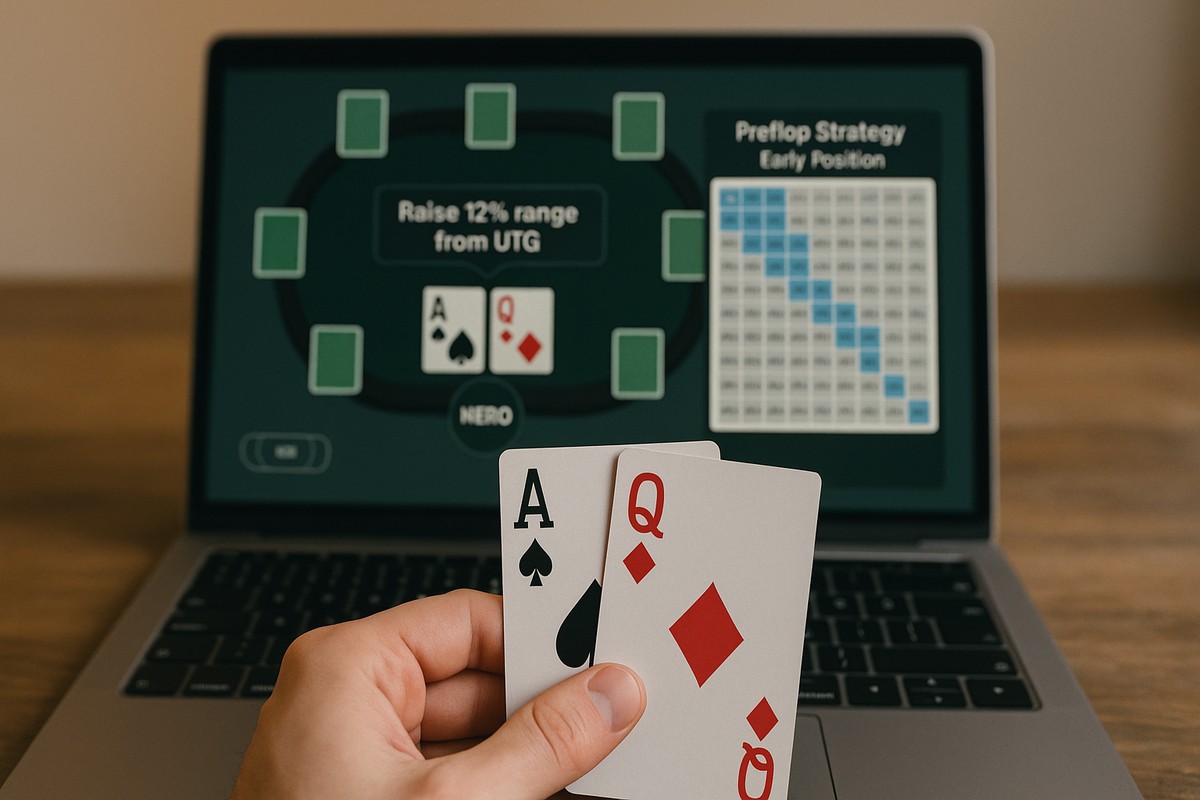
Utilizing poker ranges effectively in real money poker games is essential for making informed decisions and enhancing overall performance. A poker range represents the spectrum of hands a player might hold in a particular situation. The practical application of poker ranges varies between preflop and postflop scenarios, each demanding distinct approaches to optimize gameplay.
Preflop Poker Ranges
In preflop situations, understanding and implementing poker ranges is crucial for establishing a solid foundation for the hand. Effective use of preflop ranges involves several strategic actions that can be tailored to the dynamics of the game.
Open Raising Ranges
Open raising involves being the first to enter the pot with a raise. The selection of hands for open raising should be influenced by factors such as table position, table dynamics, and opponents’ tendencies. For instance, from an early position (UTG) in a 6-max game, a player might open raise with approximately 16% of hands, including pairs 55+, suited aces (A2s+), and broadway hands like K9s+, Q9s+, J9s+, T8s+, 98s, 87s, 76s, AJo+, and KQo. Conversely, from the button (BTN), the range can widen to about 41%, encompassing hands such as 22+, A2s+, K3s+, Q5s+, J6s+, T6s+, 96s+, 85s+, 75s+, 64s+, 54s, 43s, A2o+, K9o+, Q9o+, J9o+, and T9o. Adjusting open raising ranges based on position and table dynamics enhances strategic flexibility and effectiveness.
Preflop Calling Ranges
When facing an open raise, deciding whether to call involves assessing the strength of one’s hand relative to the raiser’s range and considering positional factors. For example, on the button facing an early position raise, a balanced calling range might include hands like JJ-22, AQs-AJs, KQs, AJo+, and KQo. In the big blind against the same raise, the calling range could expand to include TT-22, AJs-A2s, K9s+, Q9s+, J9s+, T8s+, 97s+, 86s+, 75s+, 64s+, 53s+, 43s, AJo-A9o, KTo+, QTo+, and JTo, due to the favorable pot odds and closing the action. Careful selection of calling ranges helps maintain a balanced and unpredictable strategy.
3-Bet / 4-Bet / 5-Bet Ranges
Engaging in re-raises (3-bets and beyond) requires a nuanced understanding of both one’s own range and the perceived ranges of opponents. A typical 3-bet range from the big blind against a button open might include premium hands like QQ+, AKs, AKo, and a selection of bluffs such as A2s-A5s and suited connectors like 76s. When facing a 4-bet, players must evaluate the strength of their hand against the aggressor’s likely range and decide whether to proceed with a 5-bet or to fold. Balancing these ranges and adapting to opponents’ tendencies is vital for maintaining a competitive edge in preflop confrontations.
Ranges That Fork & Split
In certain scenarios, players can employ strategies where their range diverges into distinct segments, known as forking or splitting ranges. This approach involves playing specific hands differently to create ambiguity and exploit opponents’ misconceptions. For example, a player might choose to 3-bet with both premium hands like AA, KK and selective bluffs like A5s, while opting to call with medium-strength hands such as pocket pairs and suited connectors. Such a strategy can lead opponents to misinterpret the strength of the player’s hand, resulting in strategic advantages during the hand’s progression.
Postflop Poker Ranges
After the community cards are revealed, the application of poker ranges becomes more dynamic, requiring continuous assessment and adaptation. Effectively utilizing postflop ranges involves analyzing the evolving board texture and opponents’ actions to make informed decisions.
Identifying Your Opponent’s Range
Determining an opponent’s likely range postflop involves observing their betting patterns, position, and previous behaviors. For instance, if an opponent raised preflop from an early position and the flop comes K♣9♦5♠, their range likely includes strong hands like AK, KQ, and sets, while also containing missed hands like AQ and AJ. Accurately identifying these ranges allows for strategic decisions, such as whether to call, raise, or fold, based on the perceived strength of the opponent’s hand.
Adjusting Ranges Street by Street
As the hand progresses through the flop, turn, and river, it’s crucial to refine one’s range and anticipate how opponents’ ranges may have evolved. For example, if the flop is draw-heavy and the turn completes a potential flush, the likelihood of opponents having a flush increases, necessitating a reassessment of the hand’s strength. Adapting ranges in response to these changes ensures that decisions remain aligned with the current dynamics of the hand, optimizing the potential for success.
Common Mistakes to Avoid
Misapplying poker ranges can lead to significant strategic errors. Common mistakes include overestimating the strength of one’s hand relative to the perceived range of opponents, failing to adjust ranges based on positional context, and neglecting to consider the impact of board texture on range dynamics. Additionally, becoming too predictable by adhering rigidly to standard ranges without considering the specific game context can be exploited by observant opponents. Continuous learning and adaptation are essential to avoid these pitfalls and to effectively implement poker ranges in real-game scenarios.
GTO vs Exploitative Play

In poker, players often navigate between two primary strategic approaches: Game Theory Optimal (GTO) play and exploitative play. Understanding the nuances of each strategy enables players to adapt effectively to various opponents and game situations, thereby enhancing their overall performance.
Understanding GTO Poker
Game Theory Optimal (GTO) poker refers to a strategy where a player makes decisions that are balanced and unexploitable, regardless of an opponent’s actions. By employing GTO principles, players aim to create a strategy that cannot be countered effectively, ensuring profitability against any opponent over the long term.
This involves balancing bluffs and value bets, as well as defending against bets at frequencies that prevent opponents from gaining an edge. While GTO provides a solid foundation, it requires a deep understanding of optimal frequencies and can be complex to implement fully in live play.
Exploitative Play and Range Adjustments
Exploitative play focuses on identifying and capitalizing on opponents’ specific tendencies and weaknesses. For instance, if an opponent consistently folds to 3-bets, a player might adjust by increasing their 3-bet frequency with a wider range of hands to exploit this tendency.
Conversely, against a loose player who raises 50% of hands preflop, adopting a strategy that includes 3-betting a wider range to isolate the loose player becomes advantageous. The key to successful exploitative play lies in keen observation and adaptability, allowing players to adjust their ranges and strategies dynamically based on the behavior of their opponents.
Cash Games vs Tournament Ranges
The strategic considerations for hand ranges differ significantly between cash games and tournaments due to structural and contextual variations. In cash games, with deep and relatively static stack sizes, players often employ tighter ranges, emphasizing post-flop playability and long-term profitability.
For example, in a $2/$5 cash game, the blinds remain constant, allowing for consistent strategic approaches. In contrast, poker tournaments feature increasing blinds and antes, which can lead to shorter effective stack sizes as the game progresses. This dynamic necessitates adjusting ranges to include more aggressive plays and a willingness to commit chips with a broader range of hands, especially in late-stage scenarios where survival and chip accumulation are critical.
Common Poker Player Types
To win more frequently in poker and better predict opponents’ ranges, it is essential to identify the specific player type at the table. Understanding an opponent’s tendencies allows for more informed strategic adjustments and increases the likelihood of making profitable decisions. Below are descriptions of the main player types commonly encountered in poker games. Recognising these types can provide a significant edge during gameplay.
The ABC Player
The ABC Player sticks to a basic and predictable approach in their gameplay. They bet confidently with strong hands but tend to check or fold when their hand is weak. Often playing passively and avoiding risks, they become vulnerable to aggressive strategies, as they usually fold when faced with significant pressure or bold moves from opponents.
The Bluffer
The Bluffer thrives on aggression, frequently betting and raising, even when holding weak hands in an attempt to intimidate opponents. To beat them effectively, it’s essential to play a tighter range, remain patient, and call their bluffs with strong hands, capitalizing on their tendency to over-bet and make costly mistakes.
The Thinking Player
The Thinking Player is adaptable and strategic, always adjusting their approach based on the situation at hand. Their balanced and calculated play style makes them tough to exploit and difficult to predict. However, with careful and consistent observation of their habits, you may uncover subtle patterns or weaknesses that can be used to your advantage.
Post-Hand Analysis: Learning from Past Hands
Analyzing past poker hands is a critical practice for players aiming to enhance their decision-making skills and overall performance. By systematically reviewing previous hands, players can identify mistakes, recognize successful strategies, and refine their approach for future games. This reflective process transforms experiences into valuable learning opportunities, fostering continuous improvement at the poker table.
Showdown Hand Breakdown
A thorough breakdown of hands that reach showdown offers deep insights into both one’s own play and that of opponents. By examining the actions taken at each stage—preflop, flop, turn, and river—players can assess the effectiveness of their strategies and decision-making processes. For instance, evaluating whether a continuation bet on the flop was appropriate given the board texture and opponent tendencies can reveal areas for adjustment. Utilizing tools like hand history converters and replayers facilitates this analysis, allowing for a clear reconstruction of the hand’s progression.
Pro Tip: Look for Patterns
Identifying recurring patterns in gameplay is essential for strategic development. By recognizing consistent behaviors—such as frequently folding to 3-bets or overvaluing marginal hands—players can address specific leaks in their game. Additionally, observing patterns in opponents’ play, like tendencies to bluff in certain situations or favor particular bet sizes, enables the formulation of counter-strategies. Regular post-session reviews, focusing on these patterns, contribute to a more adaptive and resilient approach at the tables.
Using Poker Ranges to Exploit and Counter Opponents
Effectively utilizing poker ranges is fundamental in both exploiting opponents’ weaknesses and fortifying one’s own defenses. By understanding and applying concepts like Minimum Defense Frequency (MDF) and tailored big blind defense strategies, players can make informed decisions that maximize profitability and minimize vulnerability.
Minimum Defense Frequency (MDF)
Minimum Defense Frequency (MDF) is a strategic concept that dictates the proportion of one’s range that must be continued—either by calling or raising—when facing a bet, to prevent opponents from profiting through excessive bluffing. The formula for MDF is:
- MDF = Pot Size / (Pot Size + Bet Size)
For example, if an opponent bets $50 into a $100 pot, the total pot becomes $150. Using the MDF formula:
- MDF = $100 / ($100 + $50) = 0.67 or 67%
This calculation suggests that to remain unexploitable, one should continue with the top 67% of their range in this scenario. Implementing MDF helps balance defense strategies, ensuring opponents cannot gain an edge through persistent aggression.
Big Blind Defense Strategies
Defending the big blind effectively is crucial, given the forced investment and positional disadvantage. Key strategies include:
- Assessing Raise Sizes: Adjust defense ranges based on the size of the open raise. Versus a standard 2.5x raise, defending with a broader range is viable, while larger raises warrant a tighter defense.
- Considering Positional Dynamics: Against late-position openers, who typically have wider ranges, one can defend more liberally, including hands like suited connectors and weaker broadways.
- Leveraging Pot Odds: The existing investment in the big blind provides favorable pot odds, justifying calls with a wider array of hands, especially when facing smaller raises.
Implementing these strategies enables players to minimize losses and capitalize on opponents’ attempts to exploit the big blind.
Adjusting to Your Opponent
Tailoring one’s strategy to exploit specific opponent tendencies is vital. For instance, against an opponent who frequently folds to aggression, increasing bluffing frequency can be profitable. Conversely, versus a calling station, emphasizing value betting with strong hands becomes advantageous. Continuous observation and adaptation to opponents’ behaviors allow for the effective application of poker ranges, enhancing overall strategic effectiveness.
Using a HUD for Poker Range Analysis

Utilizing a Heads-Up Display (HUD) can significantly enhance a poker player’s ability to analyze and calculate opponents’ ranges effectively. By providing real-time statistical data, a HUD offers insights into opponents’ tendencies, allowing for more informed decision-making.
Key Stats for Analyzing Ranges
To effectively analyze poker ranges using a HUD, attention should be focused on several critical statistics:
- Voluntarily Put Money in Pot (VPIP): Indicates the percentage of hands a player chooses to play. A high VPIP suggests a loose player engaging with a wide range of hands, while a low VPIP points to a tight player with a more selective range. For instance, a VPIP of 40% or higher may denote a loose player, whereas a VPIP below 15% indicates a tight player.
- Pre-Flop Raise (PFR): Represents the percentage of hands a player raises before the flop. Comparing PFR with VPIP helps identify playing styles; a significant gap between the two may indicate a passive approach, whereas similar values suggest aggression. For example, a player with a VPIP of 25% and a PFR of 5% is likely passive, often calling rather than raising.
- 3-Bet Percentage: Measures how frequently a player re-raises before the flop. A higher 3-bet percentage indicates a propensity for aggression and a likelihood of a broader re-raising range. For example, a 3-bet percentage above 5% suggests a more aggressive re-raising strategy.
- Fold to 3-Bet: Shows how often a player folds when facing a 3-bet. A high fold percentage can be exploited by increasing 3-bet frequency against that player, knowing they are likely to fold to re-raises.
- Aggression Factor (AF): Evaluates post-flop aggression by comparing the frequency of aggressive actions (bets and raises) to passive ones (calls). A higher AF suggests an aggressive post-flop strategy, while a lower AF indicates passivity.
By closely monitoring these statistics, players can construct accurate profiles of their opponents’ playing styles and likely hand ranges, facilitating more strategic gameplay.
Gathering Information and Making Adjustments
Accumulating data through HUD statistics enables players to make informed adjustments to their poker strategies. For instance, if a player exhibits a high VPIP but a low PFR, they are likely entering many pots without raising, indicating a passive style. In response, one might adopt a more aggressive approach, raising more frequently to exploit their passivity. Conversely, against an opponent with a high 3-bet percentage, tightening one’s opening range or being prepared to 4-bet with stronger hands can be effective. Continuous observation and adaptation based on HUD data are key to maintaining a strategic edge.
Improving Your Hand Reading Ability
Whether a novice or seasoned player, enhancing the ability to read opponents’ hands is crucial for success in poker. Accurately assessing the range of hands an opponent might hold allows for better decision-making and strategic play. The following tips can aid in developing this skill:
Always Think in Ranges
Instead of assigning a specific hand to an opponent, consider the entire range of possible hands they might have based on their actions. For example, if a tight player raises from an early position, their range likely includes premium hands such as AA, KK, QQ, AK, and AQ. By thinking in terms of ranges, players can make more nuanced decisions rather than relying on guesses about individual hands.
Shrink Ranges as You Go
As a hand progresses, use the information from each betting round to narrow down the possible hands an opponent might hold. For instance, if an opponent who raised pre-flop continues to bet on a low, uncoordinated flop, they may have a high pocket pair. However, if they check the turn when a scare card appears, it might indicate weakness, allowing you to further refine their range.
Pay Attention to Bet Sizing
An opponent’s bet sizes can provide valuable clues about the strength of their hand. A sudden large bet may indicate a strong hand or a bluff, depending on the player’s tendencies, while a small bet might suggest a drawing hand or marginal strength. For example, a player who typically bets half the pot, but suddenly bets full pot on the river may be representing a very strong hand.
Know Your Opponent
Understanding an opponent’s playing style—whether they are loose or tight, aggressive or passive—can significantly aid in hand reading. For instance, a loose-aggressive player is more likely to bluff, whereas a tight-passive player may only bet with strong hands. Tailoring your reading strategy to the specific tendencies of your opponent enhances accuracy and effectiveness.
How to Balance Your Poker Range
Balancing one’s poker range involves mixing different types of hands in a way that prevents opponents from easily discerning one’s strategy. This means occasionally bluffing with weaker hands while also betting or raising with strong hands in similar situations.
For example, if you only raise with premium hands, observant opponents will fold when you raise, reducing your profitability. By incorporating a mix of strong hands and bluffs into your raising range, you become less predictable and more challenging to play against. Achieving this balance requires careful consideration of position, opponent tendencies, and game dynamics, ensuring that your play remains both deceptive and strategically sound.
Poker Range Tips
Mastering poker ranges is essential for enhancing decision-making and overall performance at the table. By understanding and implementing the following strategies, players can refine their gameplay and gain a competitive edge.
Don’t Play Low Pocket Pairs When Short-Stacked
When holding a short stack, typically around 20 big blinds or fewer, playing low pocket pairs (such as 22 to 66) becomes less advantageous. The primary strength of these hands lies in their potential to form sets, but the implied odds diminish with a shorter stack. Investing a significant portion of a limited stack to chase a set can be detrimental, especially when the likelihood of hitting one is approximately 12%. In such scenarios, it’s often more prudent to conserve chips and await opportunities with higher equity.
Play More Suited Hands Than Offsuit Hands
Suited hands offer increased potential for flushes and straights, providing additional avenues to win pots. For instance, a hand like 8♠7♠ can connect with the board in multiple ways, enhancing its playability. Conversely, offsuit hands lack this versatility, reducing their post-flop strength. Integrating more suited hands into one’s range can lead to improved outcomes, as they offer both high card strength and the possibility of strong draws.
Don’t Overvalue Low Suited Connectors
While low suited connectors (e.g., 5♥4♥) can occasionally yield strong hands, they often require specific board textures to realize their potential. The frequency of flopping a straight or flush with these hands is relatively low, and they can be vulnerable to higher straights or flushes. Overcommitting with low suited connectors can lead to unfavorable situations, especially against opponents with stronger holdings. It’s advisable to play these hands selectively and be cautious about investing heavily without a substantial draw or made hand.
Play Tighter Than You Think from Early Position
Early position requires a more conservative approach due to the increased number of players acting afterward. Opening with a wide range exposes one to potential re-raises and challenging post-flop scenarios. Focusing on premium hands like high pocket pairs and strong broadway cards enhances one’s ability to navigate the hand effectively. This disciplined strategy helps maintain a robust table image and reduces the risk of playing marginal hands out of position.
The Essence of Hand Ranges Is Balance
Achieving balance in hand ranges prevents opponents from exploiting predictable patterns. A well-balanced range includes a mix of strong hands, drawing hands, and occasional bluffs, making it challenging for adversaries to discern one’s holdings. For example, incorporating both value bets and bluffs in similar situations keeps opponents uncertain and can lead to more profitable decisions. Striving for balance ensures adaptability and resilience against various playing styles.
Poker Ranges FAQs
What is a poker range chart?
A poker range chart is a visual representation of all possible hands a player might hold in a given situation, typically displayed on a 13×13 grid for Texas Hold’em, categorizing hands into suited, offsuit, and pocket pairs.
How do you know what your opponent’s range is?
Determining an opponent’s range involves analyzing their actions, position, and tendencies to estimate the set of hands they are likely to hold, refining this assessment as the hand progresses.
What is the significance of position-based starting hand ranges?
Position-based starting hand ranges are crucial because being in a later position allows a player to play a wider range of hands due to the advantage of acting after opponents, whereas early positions require tighter ranges to mitigate the risk of facing strong hands from others.
How do you disguise your range?
Disguising your range involves mixing up your play by occasionally including bluffs or unexpected hands in your actions, making it difficult for opponents to accurately read the strength of your holdings.
What ranges should you play preflop?
Preflop ranges should be adjusted based on position and game dynamics; for example, in early position, playing strong hands like AA, KK, QQ, AK, while in late position, incorporating a wider range including suited connectors and lower pairs is advantageous.
How do I use the poker equity chart after the flop?
After the flop, a poker equity chart helps assess the strength of your hand relative to your opponent’s potential range, guiding decisions on whether to bet, call, or fold based on the likelihood of winning the hand.
Can I rely solely on poker charts to improve my game?
While poker charts provide a solid foundation, solely relying on them is insufficient; integrating observation of opponents, adaptability, and experience is essential for comprehensive skill development.
What are push or fold charts in MTT?
Push or fold charts in Multi-Table Tournaments (MTTs) guide short-stacked players on optimal hands to go all-in with or fold, based on position and stack size, to maximize survival and potential chip accumulation.
How to define a Winamax Expresso range or a Nitro Expresso range?
Defining ranges for Winamax Expresso or Nitro Expresso involves tailoring starting hand selections to the specific dynamics and speed of these formats, often requiring more aggressive strategies due to their fast-paced nature.
What tool to learn your preflop ranges?
Tools like the Poker Hand Range Calculator and HUD assist players in learning and visualizing preflop ranges, enhancing decision-making skills.
What is a merged range?
A merged range includes strong hands, medium-strength hands, and some speculative hands, forming a continuous spectrum without significant gaps, often used to exploit opponents expecting a polarized range.
What is a polarized range?
A polarized range consists of very strong hands and bluffs, omitting medium-strength hands, aiming to maximize value from strong holdings while maintaining bluffing opportunities.
What is a capped range?
A capped range lacks the strongest possible hands, indicating that the player does not hold the nuts or near-nuts, often due to passive play or specific game dynamics.
What is a mixed range?
A mixed range incorporates a combination of different hand strengths and types, blending elements of polarized and merged ranges to create a balanced and unpredictable strategy.
-
CoinPoker4.1
- 33% Weekly
- 150% up to 2000$
T&Cs Apply | Play Responsibly | GambleAware
+18 / T & C apply / Play responsible
-
Stake.US Poker4.3
- Rakeback 5%
- $55 Stake Cash + 260K Gold Coins
T&Cs Apply | Play Responsibly | GambleAware
18+ | Play Responsibly | T&C Apply
-
Appeak Poker4.1
- 1,000 Chips Daily
- FREE 5,000 Chips
T&Cs Apply | Play Responsibly | GambleAware
T&Cs Apply | Play Responsibly | GambleAware
-
- 2,500 Gold Coins + 0.50 Sweeps Coins
T&Cs Apply | Play Responsibly | GambleAware
18+ | Play Responsibly | T&C Apply
-
WSOP.com4.3
- Up to 70%
- 100% up to $1000
T&Cs Apply | Play Responsibly | GambleAware
T&Cs Apply | Play Responsibly | GambleAware
